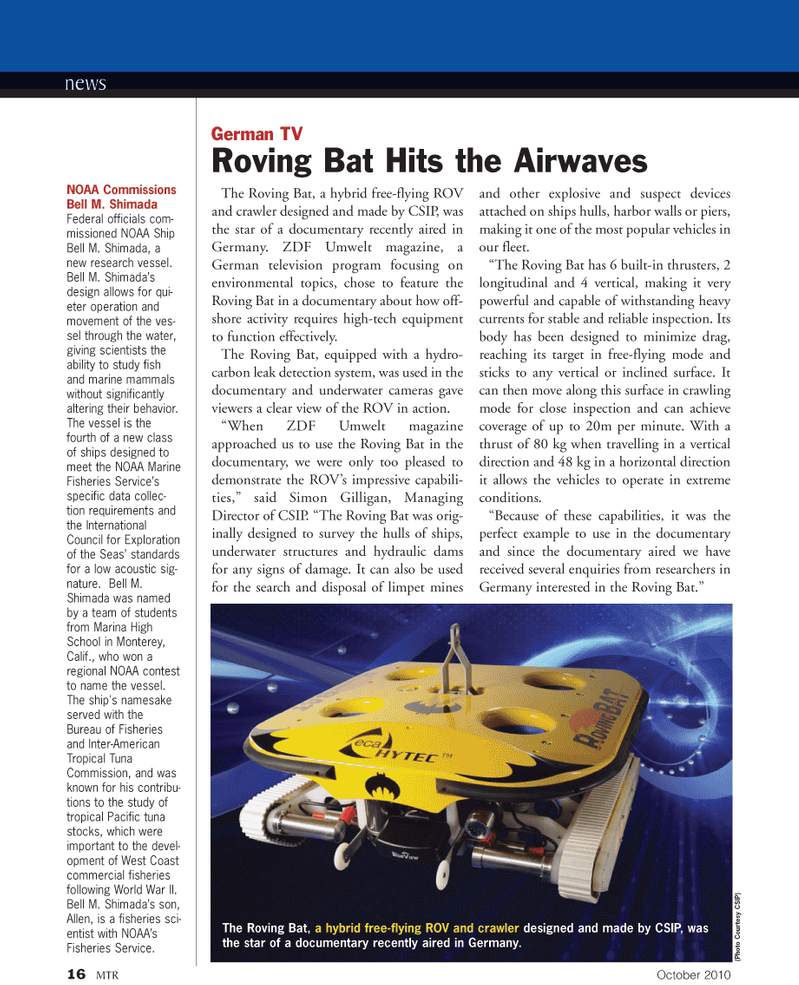
Page 16: of Marine Technology Magazine (October 2010)
Ocean Engineering & Design
Read this page in Pdf, Flash or Html5 edition of October 2010 Marine Technology Magazine
16 MTR October 2010 news
NOAA Commissions
Bell M. Shimada
Federal officials com- missioned NOAA Ship
Bell M. Shimada, a new research vessel.
Bell M. Shimada’s design allows for qui- eter operation and movement of the ves- sel through the water, giving scientists the ability to study fish and marine mammals without significantly altering their behavior.
The vessel is the fourth of a new class of ships designed to meet the NOAA Marine
Fisheries Service’s specific data collec- tion requirements and the International
Council for Exploration of the Seas’ standards for a low acoustic sig- nature. Bell M.
Shimada was named by a team of students from Marina High
School in Monterey,
Calif., who won a regional NOAA contest to name the vessel.
The ship's namesake served with the
Bureau of Fisheries and Inter-American
Tropical Tuna
Commission, and was known for his contribu- tions to the study of tropical Pacific tuna stocks, which were important to the devel- opment of West Coast commercial fisheries following World War II.
Bell M. Shimada’s son,
Allen, is a fisheries sci- entist with NOAA’s
Fisheries Service.
The Roving Bat, a hybrid free-flying ROV and crawler designed and made by CSIP, was the star of a documentary recently aired in
Germany. ZDF Umwelt magazine, a
German television program focusing on environmental topics, chose to feature the
Roving Bat in a documentary about how off- shore activity requires high-tech equipment to function effectively.
The Roving Bat, equipped with a hydro- carbon leak detection system, was used in the documentary and underwater cameras gave viewers a clear view of the ROV in action. “When ZDF Umwelt magazine approached us to use the Roving Bat in the documentary, we were only too pleased to demonstrate the ROV’s impressive capabili- ties,” said Simon Gilligan, Managing
Director of CSIP. “The Roving Bat was orig- inally designed to survey the hulls of ships, underwater structures and hydraulic dams for any signs of damage. It can also be used for the search and disposal of limpet mines and other explosive and suspect devices attached on ships hulls, harbor walls or piers, making it one of the most popular vehicles in our fleet. “The Roving Bat has 6 built-in thrusters, 2 longitudinal and 4 vertical, making it very powerful and capable of withstanding heavy currents for stable and reliable inspection. Its body has been designed to minimize drag, reaching its target in free-flying mode and sticks to any vertical or inclined surface. It can then move along this surface in crawling mode for close inspection and can achieve coverage of up to 20m per minute. With a thrust of 80 kg when travelling in a vertical direction and 48 kg in a horizontal direction it allows the vehicles to operate in extreme conditions. “Because of these capabilities, it was the perfect example to use in the documentary and since the documentary aired we have received several enquiries from researchers in
Germany interested in the Roving Bat.”
German TV
Roving Bat Hits the Airwaves
The Roving Bat, a hybrid free-flying ROV and crawler designed and made by CSIP, was the star of a documentary recently aired in Germany. (Photo Cour tesy CSIP)

 15
15

 17
17
